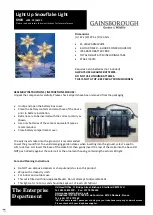
57
OpenSPR 1-Channel Operation Manual V4.1.01
7.
Once the bubble removal sequence with the 0.2 M sodium bicarbonate is complete, rinse
the injection port with 3 mL of DI water.
8.
Rinse the injection port with 2 mL of 0.5% sodium hypochlorite. While the solution is still
within the OpenSPR, perform a bubble removal injection of this solution.
9.
Once the bubble removal sequence with the 0.5% sodium hypochlorite is complete, rinse
the injection port with 3 mL of DI water.
10.
Rinse the injection port with at least another 3 mL of DI water to fully clear the lines.
3.4.2
Advanced Cleaning
If contamination of the fluidic lines within the OpenSPR is still expected after performing the
regular cleaning procedure, it is recommended to perform the advanced cleaning procedure.
Materials Required:
•
2 mL sodium dodecyl sulphate (SDS), 0.5%
•
2 mL Urea, 6 M
•
2 mL Sodium Bicarbonate, 0.2 M
•
2 mL Acetic Acid, 1%
•
2 mL Sodium Hypochlorite, 0.5%
•
DI Water, filtered
•
Blank Chip
•
6x disposable syringes with blunt-end injection tips (one syringe designated for each
solution)
Procedure:
1.
Ensure there is at least 60 mL of DI Water present in Buffer Bottle 3, and at least 30 mL of
DI water is present in a separate accessible container. Empty the Waste Bottle before
commencing.
2.
Begin the prime sequence and load a blank into the OpenSPR sample holder. Continue to
prime the OpenSPR with DI Water from Buffer Bottle 3. Allow the flow rate to continue
at the default speed of 200 µL/min.
3.
During the prime procedure, rinse the injection port with at least 3 mL of DI water using
a designated disposable syringe.
4.
When the prime is complete, rinse the injection port with 2 mL of the 0.5% SDS solution.
While the solution is still within the OpenSPR, perform a bubble removal injection of this





































